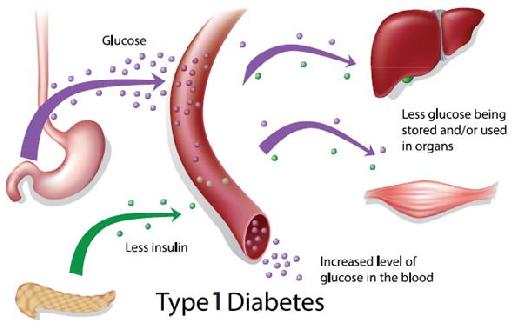
Type 2 Diabetes:
Type 2 diabetes is an incessant condition that influences the manner in which your body processes sugar (glucose) — a significant wellspring of fuel for your body.
With type 2 diabetes, your body either opposes the impacts of insulin — a hormone that manages the development of sugar into your cells — or doesn't deliver enough insulin to keep up ordinary glucose levels.
Type 2 diabetes used to be known as grown-up beginning diabetes, yet today more youngsters are diagnosed with this disorder, likely because of the ascent in youth obesity. There's no solution for type 2 diabetes, yet getting in shape, eating adequately and practicing can help deal with the disorder. In the event that diet and exercise aren't sufficient to deal with your glucose well, you may likewise require diabetes drugs or insulin treatment.
Symptoms:
Signs and manifestations of type 2 diabetes regularly grow gradually. Indeed, you can have type 2 diabetes for a considerable length of time and not know it. Symptoms may include:
- Enhanced thirst
- Frequent urination
- Expanded hunger
- Unintended weight reduction
- Exhaustion
- Obscured vision
- Moderate mending bruises
- Frequent infections
- Zones of obscured skin, ordinarily in the armpits and neck
Causes:
Type 2 diabetes grows when the body winds up impervious to insulin or when the pancreas is unfit to deliver enough insulin. Precisely why this happens is obscure, in spite of the fact that hereditary qualities and ecological components, for example, being overweight and latent, appear to contribute factors
How insulin functions
Insulin is a hormone that is produced from the organ arranged behind and beneath the stomach (pancreas).
The job of glucose
Glucose — a sugar — is a fundamental wellspring of vitality for the phones that make up muscles and different tissues.
In type 2 diabetes, this procedure doesn't function admirably. Rather than moving into your cells, sugar develops in your blood stream. As glucose levels increment, the insulin-delivering beta cells in the pancreas discharge more insulin,yet in the end these phones become impeded and can't make enough insulin to satisfy the body's needs.
In the substantially less basic type 1 diabetes, the resistant framework erroneously decimates the beta cells, leaving the body with almost no insulin.
Risk factors
Elements that may expand your danger of type 2 diabetes include:
Weight: Being overweight is a primary hazard factor for type 2 diabetes. Be that as it may, you don't need to be overweight to create type 2 diabetes.
Fat circulation: If you store fat primarily in the stomach area, you have a more serious danger of type 2 diabetes than if you store fat somewhere else, for example, in your hips and thighs. Your danger of type 2 diabetes rises in case you're a man with a midsection outline over 40 inches (101.6 centimeters) or a lady with an abdomen that is more noteworthy than 35 inches (88.9 centimeters).
Latency: The less dynamic you are, the more prominent your danger of type 2 diabetes. Physical action causes you control your weight, goes through glucose as vitality and makes your cells progressively delicate to insulin.
Family ancestry: The danger of type 2 diabetes increments if your parent or kin has type 2 diabetes.
Race: Although it's indistinct why, individuals of specific races — including dark, Hispanic, American Indian and Asian-American individuals — are bound to create type 2 diabetes than white individuals are.
Age: The danger of type 2 diabetes increments as you get more seasoned, particularly after age 45.That is presumably in light of the fact that individuals will in general exercise less, lose bulk and put on weight as they age. Be that as it may, type 2 diabetes is additionally expanding significantly among kids, teenagers and more youthful grown-ups.
Prediabetes: Prediabetes is a condition wherein your glucose level is higher than ordinary, yet not sufficiently high to be delegated diabetes. Left untreated, prediabetes frequently advances to type 2 diabetes.
Gestational diabetes: If you created gestational diabetes when you were pregnant, your danger of creating type 2 diabetes increments. On the off chance that you brought forth an infant gauging in excess of 9 pounds (4 kilograms), you're likewise in danger of type 2 diabetes.
Polycystic ovarian disorder: For ladies, having polycystic ovarian disorder — a typical condition described by sporadic menstrual periods, overabundance hair development and heftiness — builds the danger of diabetes.
Regions of obscured skin, for the most part in the armpits and neck: This condition frequently shows insulin opposition.
Complications:
Type 2 diabetes can be barely noticeable, particularly in the beginning periods when you're feeling fine. In any case, diabetes influences many real organs, including your heart, veins, nerves, eyes and kidneys. Controlling your glucose levels can help avert these intricacies.
Albeit long term complications of diabetes grow slowly, in the long run these can be incapacitating or even dangerous. A portion of the potential difficulties of diabetes include.
- You have a low sperm check or different issues with sperm
- You have a past filled with testicular, prostate or sexual issues
- You've experienced treatment for malignancy
- You have gonads that are little in size or swelling in the scrotum known as a varicocele
- You have others in your family with infertility issues
The accurate reason for sort 1 diabetes is obscure. Typically, the body's very own invulnerable framework — which regularly battles destructive microorganisms and infections — erroneously pulverizes the insulin-delivering (islet, or islets of Langerhans) cells in the pancreas.
Insulin's role:
When a noteworthy number of islet cells are decimated, you'll produce practically no insulin. Insulin is a hormone that produced from an organ arranged behind and beneath the stomach (pancreas).
- Heart and blood vessel complications.
- Damage to the kidneys
- Damage to the eyes
- Damage to the foot
- Skin and mouth complications
- Alzheimer's disease
- Sleep apnea
Prevention:
Healthy lifestyle decisions can help avert type 2 diabetes, and that is genuine regardless of whether you have diabetes in your family. On the off chance that you've effectively gotten an analysis of diabetes, you can utilize sound way of life decisions to help avert complications. On the off chance that you have prediabetic, lifestyle changes can moderate or stop the movement to diabetes further.
Subscribe to our
Newsletter
***We Promise, no spam!













